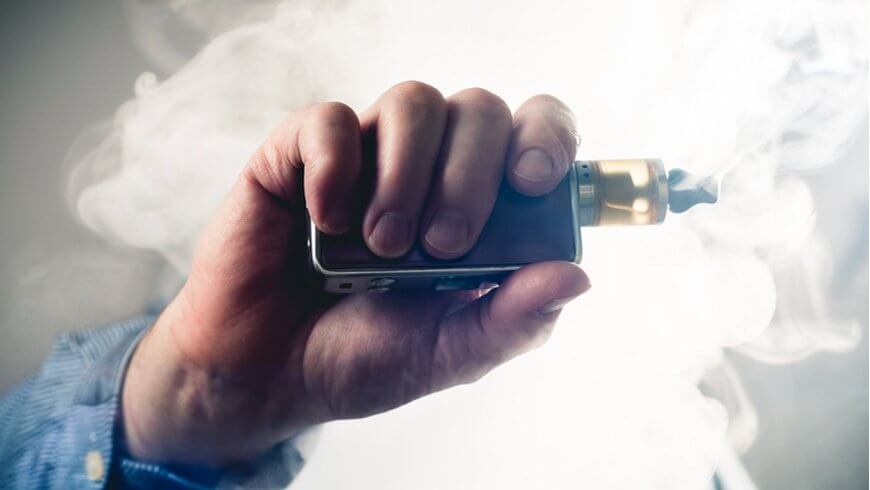One of the most pressing questions that people new to the vaping scene want answered is how much nicotine they can expect to get from their e-juice and if this will provide a workable replacement to smoking. It turns out that the answer to the first part of the question is complex enough to require an in-depth exposition. The answer to the second part of the question is generally in the affirmative: An increasing number of studies are showing that vaping is indeed a workable replacement for cigarettes. And most experts agree that the health benefits of switching from smoking to vaping are both immediate and considerable.
In this post, I’ll be focusing mostly on the questions of how much nicotine is in vape e-juice and what e-juice selections are most appropriate for those who are looking for a smoking replacement. However, I will first mention a few more important data points on the benefits of vaping versus smoking.
Vaping is a highly effective means of quitting cigarettes, but choosing the right nicotine levels is critical
An accumulating body of evidence is showing that vaping may be the single most-effective means of quitting smoking. A recent article pinpointed the smoking cessation success rate for those who switched from cigarettes to vaping at 18 percent. While this number may not sound applause worthy, it is far higher than the average 3 percent success rate seen among those who attempt to quit on their own. Vaping produces much higher success rates than even nicotine gum, which only produces successful cessation about 10 percent of the time.
However, it is extremely important to choose the right levels of nicotine for two main reason. The first is that attempting to replace smoking with vaping while not delivering enough nicotine to the body will result in continued cravings. And cravings are a huge risk factor in relapsing to smoking. The second reason is that going with too much nicotine can actually make people sick and ruin the vaping experience, likewise turning ex-smokers back to old habits. Because of its high alkalinity, concentrations of nicotine that are too high can result in extremely harsh throat hits, which can lead to coughing and a generally unpleasant overall experience.
With smoking, the levels of nicotine involved are not something that needs to be thought about much. Even people who smoke light cigarettes, with their reduced nicotine, tend to easily compensate for the lower nicotine levels by simply taking deeper hits and smoking more frequently. However, when it comes to vaping, choosing the right nicotine levels in your e-juice is a critical decision that can profoundly effect whether you are likely to stick with vaping or return to smoking’s deadly risks.
How to Convert Nicotine Percentages to mg/mL
The nicotine concentration of e-juice is often expressed in terms of milligrams per milliliter. But it can also be expressed in terms of percentages. Luckily, there is a very easy rule of thumb to use when converting milligrams per milliliter to percentages: The percentage is the milligram-per-milliliter number divided by 10.
For example, an e-juice bottle that contains 16 milligrams per milliliter of nicotine will work out to a nicotine percentage of approximately 1.6 percent.
Another issue arises when trying to figure out the cigarette equivalent of a given volume of e-juice and a given nicotine percentage. This can be a bit trickier. But as a general rule of thumb, a typical hit off of a cigarette will be equivalent to a hit from a 16 milligram-per-milliliter bottle of vape juice. It should be noted that this can vary considerably depending on the pen or mod being used. You should always test things out, only moving up or down one level of nicotine concentration when finding the right levels.
By way of example, a one milliliter bottle of e-juice will roughly contain around 100 hits. This is roughly equivalent to 10 cigarettes or a half of a pack. So, say you wanted to know roughly how many cigarettes a 5 milliliter bottle of 16-milligram-per-milliliter e-juice equates to. In this case, we know that a 1 milliliter bottle equals 10 cigarettes. So, we would just multiply that number by five, giving us a total of 50 cigarettes. This is roughly equivalent to two and a half packs of cigarettes.
Again, it cannot be emphasized enough that this is an inexact science, depending greatly on how any individual smokes cigarettes, what style, make and model of vaping rig they use and whether they are using freebase nicotine or nicotine salts. Your mileage will certainly vary, and real-world testing is the only way to get exactly the right vaping experience.
Nicotine Levels in E-juice
The nicotine levels in e-juice vary dramatically, from nicotine-free e-juice to forms comprised of potent nicotine salts that may contain up to 50 milligrams per liter or more. More commonly, vapers who are habituated to smoking will use e-juice in the range of 3 to 15 milligrams per milliliter. Heavy smokers may want to go as high as 24-milligram-per-milliliter e-juice.
This broad range of nicotine concentrations found in typical e-juice raises the question of equivalency; what concentration of nicotine in an e-juice should someone look for if they would like their vaping experience to roughly equal a given number of cigarettes? This last question turns out to be considerably difficult to answer and depends heavily on the type of vaping device that is used, the size of the draws the vaper is taking and how they normally smoked cigarettes.
But a solid rule of thumb is that a single milliliter bottle of e-juice will yield about 100 hits. In the roughest estimate, this means that one bottle of e-juice is equivalent, in terms of hits, to about five packs of cigarettes. All things being equal, the milligram-adjusted effects of nicotine released through vaping are way more intense than nicotine that is released through smoking. This is especially true for sub-Ohm vaping, where the vaporization is more complete, and most experienced cigarette smokers are content with e-juice that contains between 3 and 6 milligrams per milliliter.
The bottom line is that the appropriate levels of nicotine in an e-juice is something that has been tested — quite literally ad nauseam, as levels that are too high often produce sickness — in the real world by tens of millions of smokers and former smokers. What we know is that smokers in different use categories can ingest enough nicotine that they will be unlikely to experience cravings for cigarettes. In rough terms, the right e-juice nicotine levels for a given user profile can be broken down in the following way:
- E-juice containing no nicotine is great for those who simply love to vape but will obviously provide no benefit beyond a mechanical smoking substitute to those trying to wean themselves off of nicotine.
- E-juice with between 3 and 6 milligrams per milliliter of nicotine is a great choice for those who are trying to reduce their daily nicotine consumption but is unlikely to fully satisfy cravings of regular smokers.
- E-juice with 12 milligrams per milliliter of nicotine is widely considered to be a concentration that is adequate to replace a one-pack-per-day smoking habit.
- At nicotine concentrations of 18 milligrams per milliliter, e-juice will be able to serve a replacement for moderate to heavy smoking that involves at least a pack per day.
- E-juices that contain 24 milligrams per milliliter are considered highly concentrated and should only be used by heavy smokers who smoke more than two packs per day.
- E-juice with concentrations of 36 milligrams per milliliter or more can potentially deliver dangerous levels of nicotine and should only be used to dilute lower-nicotine-level e-juices.
As alluded to earlier, it is mostly agreed upon that e-juice containing about 16 milligrams per milliliter of nicotine will produce per-hit nicotine levels that are equivalent to full-flavor cigarettes. E-juice at about the 11-milligram-per-milliliter level is roughly equivalent, on a per-hit basis, with light cigarettes and e-juice with 24 milligrams per milliliter of nicotine are roughly equivalent, per hit, with the strongest cigarettes.
| Vapor Production | Regular e-juice | Nicotine salts | |
| High vapor | 0ml | does not contain nicotine at all, for individuals who have worked their way down from higher vape juice nicotine levels, or want to vape without nicotine. | Up to 10 mg/mL |
| 3ml | 3ml is the lowest level,best for vapers who are stepping down from higher vape nicotine levels, or those who were only light (less than 10 cigarettes per day) smokers previously. | ||
| 6ml | 6ml for people who wish to enjoy a full e-juice taste but with a low level | ||
| Medium vapor | 8ml | 8ml for those who used to smoke 1 pack a day | 20-30 mg/mL |
| Low vapor | 12ml | 12mg/mL is usually best for new vapers who were formally heavy cigarette smokers (up to 30 cigarettes per day), or smokers of unfiltered cigarettes. | 30-60 mg/mL |
| 18ml | for those who used to smoke more than 1 pack a day | ||
| 24ml | a very high level; for heavy smokers who used to smoke more than 2 packs a day | ||
| 36ml | the highest level, used to dilute an e-juice with a low level of nicotine | ||
| Tips | When change nicotine level, it's recommended that you only move up or down 1 level | ||
Nicotine Salts
A special mention must be made of nicotine salts. Most e-juice and all cigarettes contain the simpler form of freebase nicotine. Nicotine salts are formed by chemically adding benzoic acid to nicotine. The chemical definition of a salt is an acid and a base that undergo a neutralization reaction. The result is a substance with a middling pH level rather than the high alkalinity or acidity of the component chemicals that make it up.
This may sound overly technical. But for vaping, it means one thing: Nicotine salts deliver much mellower hits. This is important because the quality of the hit is one of the key factors that determine whether people stick with vaping or relapse to smoking.
However, nicotine salts tend not to vaporize as readily as freebase nicotine. And when they do vaporize, they still aren’t as bioavailable or easily absorbed by the body as freebase. This means that e-juice containing nicotine salts is often available at much higher concentrations than e-juice that uses freebase nicotine. A general rule of thumb is that e-juices that contain nicotine salts will smoke at about half the effective concentration as they would if they contained freebase nicotine. In other words, if you’re used to freebase-nicotine e-juice with a concentration of 12 milligrams of nicotine per milliliter, then going with a nicotine-salt-based e-juice with a concentration of about 24 milligrams per milliliter will be about right.
However, it should be noted that this rule of thumb may break down when using nicotine salts with sub-Ohm vaping devices, which may be able to much more thoroughly vaporize the nicotine salts. Therefore, extreme caution should be exercised when first attempting to vape nicotine salts with sub-Ohm pens or mods. Failing to do so could result in a mild nicotine overdose, which may be intensely unpleasant.
Nicotine Levels When Vaping Versus Smoking
As I’ve already illustrated, the levels of nicotine required for any individual smoker to get a similar vaping experience with adequate satisfaction of the nicotine cravings is an inexact science at best. The nature of vaping versus smoking is that the former involves a completely different physical process, leading to very different consumption profiles of the nicotine present. In general, vaping tends to deliver far more nicotine than smoking.
To see to what extent this is true, consider that the typical full-flavor cigarette contains around 12 milligrams of nicotine. This is as much as an entire bottle of typical e-juice! Yet, the typical smoker only takes about 10 hits off of that cigarette while they may get up to 100 hits off the bottle of e-juice. But this does not mean that the smoker is only getting 1/10th the amount of nicotine from their cigarette that they would ingest while vaping.
The reason has to do with how combustion affects the release of nicotine as well as the fact that many smokers may end up wasting a half or more of a typical cigarette just by letting it burn.
But that’s not to say that there isn’t a profound difference between smoking and vaping. The two biggest differences are large indeed. The first is that vaping is radically safer than smoking. Cigarette smoke contains thousands of chemicals and dozens of potent carcinogens, none of which vapers are ever exposed to. The second difference is that vaping is massively less expensive than smoking. Because vaping is a far more efficient means of ingesting nicotine, it is also a far cheaper way to get your nicotine fix.






COMMENTS